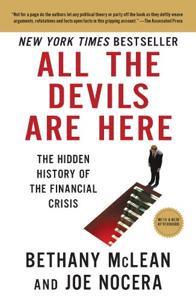
Want to learn the ideas in All the Devils Are Here better than ever? Read the world’s #1 book summary of All the Devils Are Here by Bethany McLean, Joe Nocera here.
Read a brief 1-Page Summary or watch video summaries curated by our expert team. Note: this book guide is not affiliated with or endorsed by the publisher or author, and we always encourage you to purchase and read the full book.
Video Summaries of All the Devils Are Here
We’ve scoured the Internet for the very best videos on All the Devils Are Here, from high-quality videos summaries to interviews or commentary by Bethany McLean, Joe Nocera.
1-Page Summary of All the Devils Are Here
Overall Summary
All the Devils are Here is a book by David Seabrook, which looks into the history of England’s Kent coast. It talks about how this area has been affected by economic decline and links it to artists from the past who lived there. The author also discusses some contemporary issues that have impacted this region. Some of these include writers with connections to Kent like Charles Dickens, T.S. Eliot, Robin Maugham, and John Buchan; however, he also mentions other people such as William Blake and Virginia Woolf who were born in or near London but spent time on the coast during their lives. This book was published after David Seabrook’s death at age 48 in his flat where he died alone with no one knowing what had happened for weeks afterward until someone found him dead.
The author begins his story in Margate, which is a town that’s known for its economic hardships. He goes on to describe the setting as being “as ripe as ever for a low-budget remake of Brighton Rock: the joyless amusement arcades, the facial scars.”
Seabrook is searching for evidence of the time T.S. Eliot spent in Margate, England. He wants to find out how The Waste Land was written and what it means, as well as why it’s important today. According to Seabrook, Eliot stayed in Margate after a nervous breakdown in 1921 and wrote one of his most famous poems there; he mentions that the poem contains a reference to an event that happened at the time—a suicide by an ex-serviceman who had been traumatized during World War I.
The author then goes to Margate, a seaside town in Kent. He describes it as “a place that is largely unhappy” and notes how Charles Dickens spent the last decade of his life there before dying at age 58. The author also mentions that this area has become a tourist destination with many people visiting for its Victorian-era attractions. Next, he visits Rochester where he sees schools dressed up like chimney sweeps from the Victorian era. The author draws a distinction between historic time and heritage time by pointing out how Rochester exists in heritage time rather than historic times now because of the tourism industry which focuses on Victoriana rather than history or actual events that happened there.
The next stop is Chatham Dockyard where Seabrook points out that things can be worse than being stuck in the past; they can actually be dead—like necro-Victoriana instead of retro-Victoriana (things are just dead). After some more traveling, Seabrook arrives at Gravesend and meets an old friend who takes him to London via train where they discuss their lives since high school together while drinking beer and eating chips on their journey home to London from Gravesend.
Seabrook traces the appearances of Kent in Dickens’ novels. In Great Expectations, Magwitch escapes from a prison ship on the Medway, and Miss Havisham lives in Rochester (at that time more upscale than today). Seabrook speculates that Dickens may have been obsessed with a grisly patricide that took place nearby.
In Broadstairs, Seabrook found a connection to John Buchan’s novel The Thirty-Nine Steps and from there weaves a complex and intriguing picture of life in Broadstairs in the thirties. He focuses on Dr. Arthur Albert Tesler, who was involved with Nazis during World War II. His connections were reported by the Thanet Express: “many Thanet people have read with interest this week reports received from Bucharest.”
Throughout the story, Seabook reveals that he is a very sensitive person. He refuses to talk to people and spends hours at historical sites. Finally, the book follows Seabook as he goes out with his friend Gordon, who has many stories about famous penises from Kent history (and Seabrook’s social circle). After drinking with Gordon, Seabook goes cruising at a local bar and reveals some of his private pain: “There are things I haven’t mentioned. Private matters. They’re on me all day long.”






